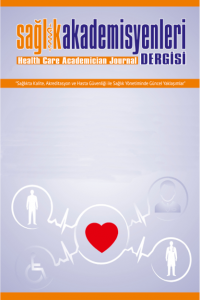gestasyonel süreçte iletişim
İletişim, empati, gebelik, sağlık profesyonelleri
___
- 1. Chichirez CM, Purcărea VL. Interpersonal communication in healthcare. J Med Life. 2018;11(2):119-22.
- 2. Lippke S, Wienert J, Keller FM, Derksen C, Welp A, Kötting L, et al. Communication and patient safety in gynecology and obstetrics - study protocol of an intervention study. BMC Health Services Research. 2019;19(1):908.
- 3. Forsey J, Ng S, Rowland P, Freeman R, Li C, Woods NN. The Basic Science of Patient–Physician Communication: A Critical Scoping Review. Academic Medicine. 2021;96(11S):S109-S18.
- 4. Rowe RE, Garcia J, Macfarlane AJ, Davidson LL. Does poor communication contribute to stillbirths and infant deaths? A review. Journal of Public Health Medicine. 2001;23(1):23-34.
- 5. Decety J. Empathy in Medicine: What It Is, and How Much We Really Need It. The American Journal of Medicine. 2020;133(5):561-6.
- 6. Markides M. The Importance of Good Communication Between Patient and Health Professionals. Journal of Pediatric Hematology/Oncology. 2011;33:S123-S5.
- 7. Institute of Medicine Committee on Quality of Health Care in A. Crossing the Quality Chasm: A New Health System for the 21st Century. Washington (DC): National Academies Press (US) Copyright 2001 by the National Academy of Sciences. All rights reserved.; 2001.
- 8. Liu W, Hao Y, Zhao X, Peng T, Song W, Xue Y, et al. Gender differences on medical students' attitudes toward patient-centred care: a cross-sectional survey conducted in Heilongjiang, China. PeerJ. 2019;7:e7896-e.
- 9. Venetis MK, Robinson JD, Turkiewicz KL, Allen M. An evidence base for patient-centered cancer care: a meta-analysis of studies of observed communication between cancer specialists and their patients. Patient education and counseling. 2009;77(3):379-83.
- 10. Shakibazadeh E, Namadian M, Bohren MA, Vogel JP, Rashidian A, Nogueira Pileggi V, et al. Respectful care during childbirth in health facilities globally: a qualitative evidence synthesis. BJOG : an international journal of obstetrics and gynaecology. 2018;125(8):932-42.
- 11. Werder O. Toward a humanistic model in health communication. Global Health Promotion. 2017;26(1):33-40.
- 12. The Handbook of Behavior Change. In: Hamilton K, Cameron LD, Hagger MS, Hankonen N, Lintunen T, editors. The Handbook of Behavior Change. Cambridge Handbooks in Psychology. Cambridge: Cambridge University Press; 2020. p. i-ii.
- 13. Hannawa A. “SACCIA Safe Communication”: Five core competencies for safe and high-quality care. Journal of Patient Safety and Risk Management. 2018;23:99-107.
- 14. Cheng B, Bridges S, Yiu C, McGrath C. A review of communication models and frameworks in a healthcare context. Dental update. 2015;42:185-6, 9.
- 15. Suchman AL, Markakis K, Beckman HB, Frankel R. A model of empathic communication in the medical interview. Jama. 1997;277(8):678-82.
- 16. Diaz JA, Griffith RA, Ng JJ, Reinert SE, Friedmann PD, Moulton AW. Patients’ use of the internet for medical information. Journal of General Internal Medicine. 2002;17(3):180-5.
- 17. Sayakhot P, Carolan-Olah M. Internet use by pregnant women seeking pregnancy-related information: a systematic review. BMC Pregnancy and Childbirth. 2016;16(1):65.
- 18. Rothman BK. Pregnancy, birth and risk: an introduction. Health, Risk & Society. 2014;16(1):1-6.
- 19. Coco L, Giannone TT, Zarbo G. Management of high-risk pregnancy. Minerva ginecologica. 2014;66(4):383-9.
- 20. Corrigan CP, Kwasky AN, Groh CJ. Social Support, Postpartum Depression, and Professional Assistance: A Survey of Mothers in the Midwestern United States. J Perinat Educ. 2015;24(1):48-60.
- 21. Cheng B, Bridges S, Yiu C, McGrath C. A review of communication models and frameworks in a healthcare context. Dental update. 2015;42:185-6, 9.
- ISSN: 2148-7472
- Yayın Aralığı: Yılda 4 Sayı
- Başlangıç: 2014
- Yayıncı: Dünya Kongre
TOPLUMUN SAĞLIK ÇALIŞANLARINA YÖNELİK ŞİDDET KONUSUNDAKİ TUTUMU
Seda ÜNAL, Emel FİLİZ, Şeyma KAHVECİ, Sultan UYAR
Sağlık Kurulunda Çalışanların İletişim Sorunları ve Çözüm Önerileri Üzerine Nitel Bir Araştırma
Nilay GEMLİK, Rukiye ŞEKER, Ali ARSLANOĞLU, Özgür ÇENGEL
OTOİMMÜN TİROİDİTİ OLAN HASTALARDA PREMATÜR OVARYAN YETMEZLİK SIKLIĞI
Ceren YILDIZ EREN, Hulusi Göktuğ GÜRER, Özlem ÖZGÜR GÜRSOY, Ozge GODEK
PATOLOJİ LABORATUVARINDA MAKROSKOPİ TEKNİKERİNİN ROLÜ
Mustafa HÜZ, Kutsal YÖRÜKOĞLU, Nusret AKPOLAT
Mansur Seymen SEĞMENOĞLU, Hilal KUŞCU KARATEPE
Esin TEMELOĞLU ŞEN, H. Özlem SERTEL BERK, Dilsad SİNDEL
Anemide Gebelik Sonuçları ve Bakım
Gelişmekte Olan Ülkelerin Sağlık Sistemi Göstergelerinin Karşılaştırmalı Analizi
Canser BOZ, Salim YILMAZ, Haluk ÖZSARI
OBSTETRİDE VE JİNEKOLOJİDE APİTERAPİNİN KULLANIMI
